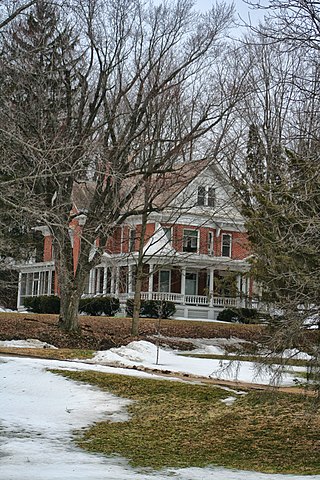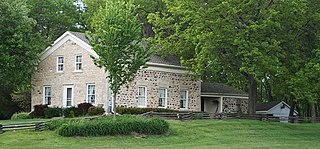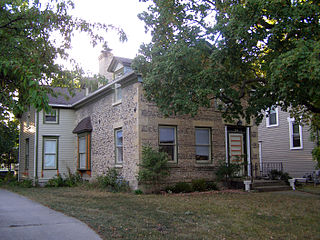
Mequon is the largest city in Ozaukee County, in the U.S. state of Wisconsin, and the third-largest city in Wisconsin by land area. Located on Lake Michigan's western shore with significant commercial developments along Interstate 43, the community is a suburb in the Milwaukee metropolitan area. Despite being an incorporated city, approximately half of Mequon's land is undeveloped and agriculture plays a significant role in the local economy. At the time of the 2010 census the population was 23,132.

The First Unitarian Society of Madison (FUS) is a Unitarian Universalist congregation in Shorewood Hills, Wisconsin. Its meeting house was designed by Frank Lloyd Wright and built by Marshall Erdman in 1949–1951, and has been designated a U.S. National Historic Landmark for its architecture. With over 1,000 members, it is one of the ten largest Unitarian Universalist congregations in the United States.

This is a list of the National Register of Historic Places listings in Ozaukee County, Wisconsin. It is intended to provide a comprehensive listing of entries in the National Register of Historic Places that are located in Ozaukee County, Wisconsin. The locations of National Register properties for which the latitude and longitude coordinates are included below may be seen in a map.

Washington Avenue Historic District is the historic center of Cedarburg, Wisconsin, the location of the early industry and commerce that was key to the community's development. The historic district was listed on the National Register of Historic Places (NRHP) in 1986.

Mequon Town Hall and Fire Station Complex is an Art Deco building complex in Mequon, Wisconsin, United States, that was built in 1937 as a Works Progress Administration project. It was listed on the National Register of Historic Places in 2000.

The Fred B. Jones House is part of an estate called Penwern in Delavan, Wisconsin, designed by Frank Lloyd Wright and constructed from 1900 to 1903. It was listed on the National Register of Historic Places in 1974.

The Keim Homestead is a historic farm on Boyer Road in Pike Township, Berks County, Pennsylvania. It was built in 1753 for Jacob Keim and his wife Magdalena Hoch on land given to the couple by her father. Jacob was the son of Johannes Keim, who immigrated from Germany in 1689 and scouted the Pennsylvania countryside for land that was similar in richness to the soil from the Black Forest of Germany. He thought he found it and returned to Germany, married his wife, Katarina. They came to America in 1707. Keim originally built a log structure for his family's housing and later a stone home along Keim Road in Pike Township. The main section of the Jacob and Magdelena Keim house on Boyer Road was built in two phases and it is, "replete with early German construction features ... including[an] extremely original second floor Chevron door." The exterior building material (cladding) is limestone. The finishings and trimmings are mostly original to the house; relatively unusual in a home of this period.

St. Joseph's Catholic Church Complex is located in Waukesha, Wisconsin. The church building itself was built in 1888. On October 28, 1983, the complex was added to the National Register of Historic Places for its architectural significance.

St. Peter's Roman Catholic Church is a Neogothic-styled church built in 1901 in the small farming community of Ashton, Wisconsin in the town of Springfield, Dane County, Wisconsin. It was added to the National Register of Historic Places in 1980.

Saints Peter and Paul Roman Catholic Church Complex is located in Milwaukee, Wisconsin. The complex was added to the National Register of Historic Places in 1991 for its architectural significance.

The Freitag Homestead is a historic farm begun in 1848 in the town of Washington, Green County, Wisconsin. It is also the site of the first Swiss cheese factory in Wisconsin. The farm was added to the National Register of Historic Places in 2005.
The Benton Stone Water Tower is located in Benton, Wisconsin. It was added to the National Register of Historic Places in 1999.

The John Reichert Farmhouse is a Stick style house built around 1885 and located in Mequon, Wisconsin, United States. It was added to the National Register of Historic Places in 1982.

The Bigelow School is a historic former school located at 4228 W. Bonniwell Rd. in Mequon, Wisconsin. The one-story red brick school was built in 1929; it was one of the last schools built in Mequon and is one of many extant school buildings from the late 19th and early 20th centuries in the city. Designed by William J. Redden, the school's architecture utilizes the Classical Revival and Prairie School styles and features a hipped roof, flaring eaves, and a front entry decorated with a brick surround and a stone keystone and plaque. The school closed in the 1960s due to school consolidation.

The Jonathan Clark House is a historic house located at 13615 N. Cedarburg Rd. in Mequon, Wisconsin. The house was built in 1848 for Jonathan Clark, who migrated to the area from Vermont. The home was built in the Greek Revival style and is built in fieldstone with a limestone front. The house has also been used as a dentist's office.

The Edwin J. Nieman Sr. House is a historic house located at 13030 North Cedarburg Road in Mequon, Wisconsin. The house was added to the National Register of Historic Places on April 12, 1996.

The Lathrop-Munn Cobblestone House is a 1.5-story Greek Revival-styled house built about 1848 in Beloit, Wisconsin, striking for the care with which the mason arranged the tiny cobbles. In 1977 the building was placed on the National Register of Historic Places.

The Gulbrand and Bertha Jensvold House is a historic farmhouse built in 1868–69 in Perry, Wisconsin. It was added to the State Register of Historic Places in 2007 and to the National Register of Historic Places the following year.

The Frederick Schumann Farmstead is a well-preserved saltbox-shaped stone farmhouse built by a German immigrant family in 1878 in Berry, Wisconsin. In 1993 it was listed on the National Register of Historic Places.

The Eric and Jerome Skindrud Farm is a farm started by Norwegian immigrants in Springdale, Wisconsin with intact farm buildings as old as 1876. The farm lies in a big valley prone to erosion and was early to try out erosion control dams and planting crops in contour strips. In 1994 the farm was added to the State and the National Register of Historic Places.



















